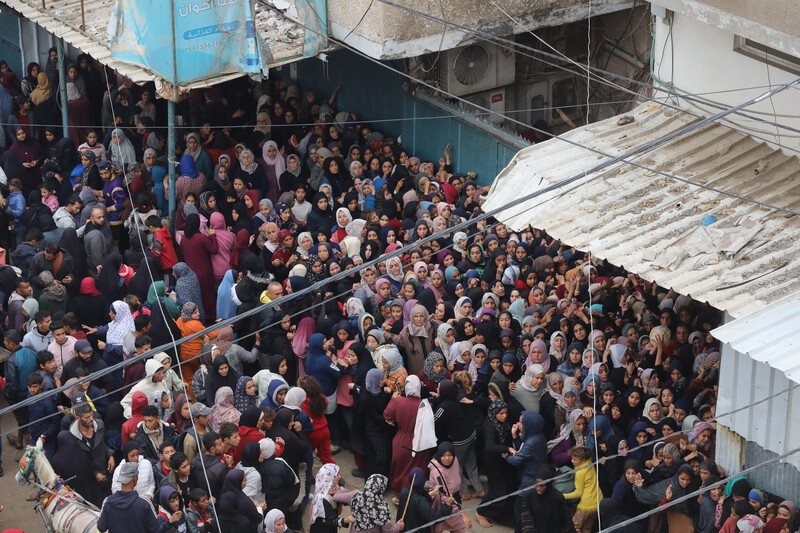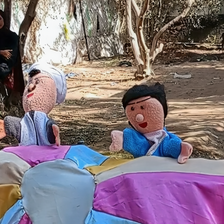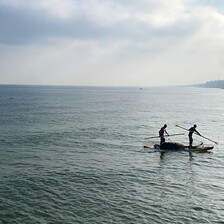The Electronic Intifada 22 January 2025

Hundreds of people gather to buy bread from a bakery in Deir al-Balah, Gaza on November 29, 2024.
APA imagesIn late November, two girls and a woman were crushed to death when trampled by a crowd of starving customers at al-Banna Bakery in Deir al-Balah.
Nisreen Fayyad, 50, a mother of four, Rahaf Abu Laban, 17, and Zeina Juha, 11 were all killed in an incident that dramatically illustrated the desperation of starving Palestinians in Gaza before a ceasefire came into effect last Sunday.
Since then, Israel has finally allowed significant amounts of humanitarian aid to enter Gaza after 15 months of an imposed blockade on food, water, electricity, medicine and fuel.
But before that, Gaza’s 2.3 million people were having to survive an imposed famine that had spread across Gaza in July last year when the UN said that 34 people, mostly children, had died of malnutrition.
To make matters worse, Gaza’s police had been forced out of uniform after being repeatedly targeted by the Israeli military, leaving it to volunteers to try to manage starving crowds.
None of this was any comfort to grieving relatives.
“All we wanted was some bread to live another day, but they took my mother from us,” Nisreen’s daughter Salwa, 19, told The Electronic Intifada. “Why do we have to die for a bite?”
Amer al-Muqayyad, who was displaced from Gaza City to Deir al-Balah, was also in the crowd that day.
“I stood for six hours in front of the bakery trying to get some bread, but I failed because of the severe crowding.”
Bread line tragedies
“Hunger and despair” is how Ismail al-Thawabtah, director general of the Gaza government media office, described the situation to The Electronic Intifada.
Palestinians across the Gaza Strip rely heavily on bakeries and charity kitchens, with many only able to secure one meal a day for their families, he said.
“Almost everyone depends on humanitarian aid to survive,” al-Thawabteh said.
By early December, most bakeries in southern Gaza had closed due to a shortage of flour, driving people to the few that remained open.
The lack of aid and the shortage of flour was so acute that it left people “scavenging for food amid piles of garbage in parts of the Gaza Strip,” Ajith Songhai, head of the UN human rights office in the occupied Palestinian territory, said during a news conference in Geneva last November, Reuters reported.
Three other women were killed late in November while trying to get bread in a separate incident at the Zadna bakery in Deir al-Balah.
They were killed by bullet ricochets when, in an attempt to control the chaos at the bakery, some young men belonging to what is known locally as the Popular Protection Committees fired bullets into the air. The bullets hit an iron ceiling and rebounded, killing the three women.
Abu Murad, a member of the Popular Protection Committees, said these committees “were formed as an alternative to the trained elements of the security services who are being systematically subjected to Israeli bombardment.”
Popular Protection Committees emerged as a local response to maintain security and civil peace, Abu Murad, who did not want to be identified further, told The Electronic Intifada.
But volunteers had scant training and, in many cases, relied on personal experience to handle crowds and informal weapons training at best.
Gang collusion
In addition to imposing a famine and targeting civil police, the Israeli military in some cases appeared to collude with local gangs who would steal whole truckloads of food in order to sell them on for inflated prices.
Abu Habib, a security officer affiliated with the security services in Gaza who also declined to be identified further, said that such gangs were operating in areas controlled by the Israeli army, where no Palestinians were officially allowed.
On 16 November 2024, for instance, nearly 100 aid trucks delivering humanitarian assistance to people in Gaza were looted.
By all accounts, the looting took place in murky circumstances. At short notice the Israeli military ordered the convoy, which had been held for inspection at the Kerem Abu Salem crossing in the south, to depart the crossing and proceed into Gaza via an unfamiliar route.
No reason for the change of route or sudden departure was given, according to UNRWA official Louisa Wateridge, but somehow gangs inside Gaza were lying in wait.
Abu Habib pointed out that the security services in Gaza have tried to confront these gangs, “but every time, we are exposed to Israeli bombing and killing.”
On 15 November, Oxfam, CARE, Save the Children and other nongovernmental organizations issued a joint statement saying that the looting of aid reaching Gaza had become easier because the Israeli military has targeted local police who could have prevented the looting.
The Washington Post reported on 18 November that, according to an internal UN memo, the Israeli military is providing “passive” protection for armed criminal gangs.
The return of uniformed police to the streets of Gaza after the ceasefire has brought some much needed order to the area.
But everything hinges on humanitarian aid being allowed continued free access to the people of Gaza.
Rasha Abou Jalal is a journalist in Gaza.





